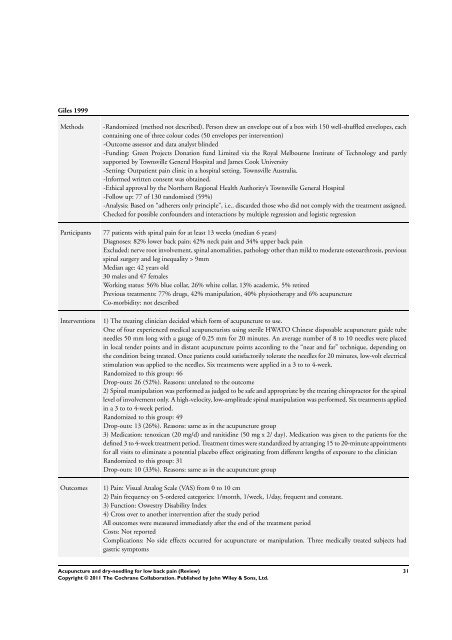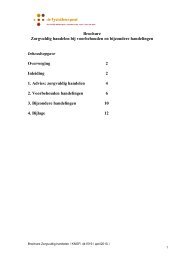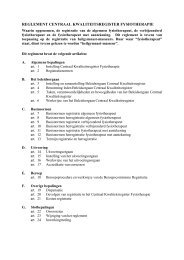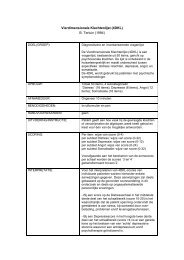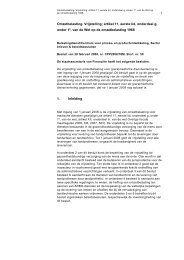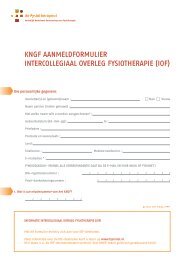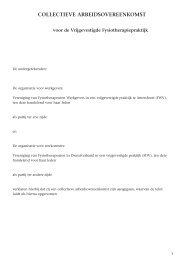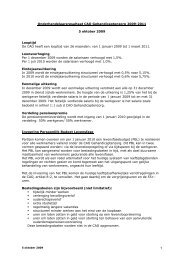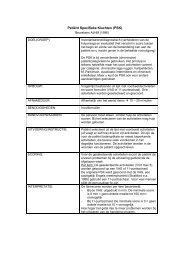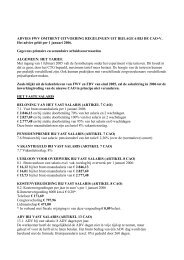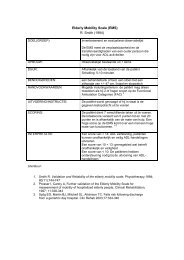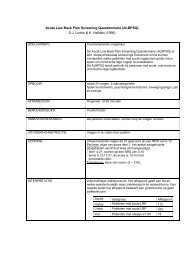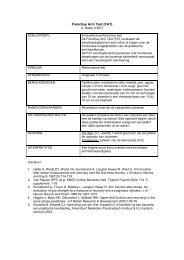Acupuncture and dry-needling for low back pain (Review)
Acupuncture and dry-needling for low back pain (Review)
Acupuncture and dry-needling for low back pain (Review)
Create successful ePaper yourself
Turn your PDF publications into a flip-book with our unique Google optimized e-Paper software.
Giles 1999<br />
Methods<br />
Participants<br />
Interventions<br />
Outcomes<br />
-R<strong>and</strong>omized (method not described). Person drew an envelope out of a box with 150 well-shuffled envelopes, each<br />
containing one of three colour codes (50 envelopes per intervention)<br />
-Outcome assessor <strong>and</strong> data analyst blinded<br />
-Funding: Green Projects Donation fund Limited via the Royal Melbourne Institute of Technology <strong>and</strong> partly<br />
supported by Townsville General Hospital <strong>and</strong> James Cook University<br />
-Setting: Outpatient <strong>pain</strong> clinic in a hospital setting. Townsville Australia.<br />
-In<strong>for</strong>med written consent was obtained.<br />
-Ethical approval by the Northern Regional Health Authority’s Townsville General Hospital<br />
-Fol<strong>low</strong> up: 77 of 130 r<strong>and</strong>omised (59%)<br />
-Analysis: Based on “adherers only principle”, i.e.. discarded those who did not comply with the treatment assigned.<br />
Checked <strong>for</strong> possible confounders <strong>and</strong> interactions by multiple regression <strong>and</strong> logistic regression<br />
77 patients with spinal <strong>pain</strong> <strong>for</strong> at least 13 weeks (median 6 years)<br />
Diagnoses: 82% <strong>low</strong>er <strong>back</strong> <strong>pain</strong>; 42% neck <strong>pain</strong> <strong>and</strong> 34% upper <strong>back</strong> <strong>pain</strong><br />
Excluded: nerve root involvement, spinal anomalities, pathology other than mild to moderate osteoarthrosis, previous<br />
spinal surgery <strong>and</strong> leg inequality > 9mm<br />
Median age: 42 years old<br />
30 males <strong>and</strong> 47 females<br />
Working status: 56% blue collar, 26% white collar, 13% academic, 5% retired<br />
Previous treatments: 77% drugs, 42% manipulation, 40% physiotherapy <strong>and</strong> 6% acupuncture<br />
Co-morbidity: not described<br />
1) The treating clinician decided which <strong>for</strong>m of acupuncture to use.<br />
One of four experienced medical acupuncturists using sterile HWATO Chinese disposable acupuncture guide tube<br />
needles 50 mm long with a gauge of 0.25 mm <strong>for</strong> 20 minutes. An average number of 8 to 10 needles were placed<br />
in local tender points <strong>and</strong> in distant acupuncture points according to the “near <strong>and</strong> far” technique, depending on<br />
the condition being treated. Once patients could satisfactorily tolerate the needles <strong>for</strong> 20 minutes, <strong>low</strong>-volt electrical<br />
stimulation was applied to the needles. Six treatments were applied in a 3 to to 4-week.<br />
R<strong>and</strong>omized to this group: 46<br />
Drop-outs: 26 (52%). Reasons: unrelated to the outcome<br />
2) Spinal manipulation was per<strong>for</strong>med as judged to be safe <strong>and</strong> appropriate by the treating chiropractor <strong>for</strong> the spinal<br />
level of involvement only. A high-velocity, <strong>low</strong>-amplitude spinal manipulation was per<strong>for</strong>med. Six treatments applied<br />
in a 3 to to 4-week period.<br />
R<strong>and</strong>omized to this group: 49<br />
Drop-outs: 13 (26%). Reasons: same as in the acupuncture group<br />
3) Medication: tenoxican (20 mg/d) <strong>and</strong> ranitidine (50 mg x 2/ day). Medication was given to the patients <strong>for</strong> the<br />
defined 3 to 4-week treatment period. Treatment times were st<strong>and</strong>ardized by arranging 15 to 20-minute appointments<br />
<strong>for</strong> all visits to eliminate a potential placebo effect originating from different lengths of exposure to the clinician<br />
R<strong>and</strong>omized to this group: 31<br />
Drop-outs: 10 (33%). Reasons: same as in the acupuncture group<br />
1) Pain: Visual Analog Scale (VAS) from 0 to 10 cm<br />
2) Pain frequency on 5-ordered categories: 1/month, 1/week, 1/day, frequent <strong>and</strong> constant.<br />
3) Function: Oswestry Disability Index<br />
4) Cross over to another intervention after the study period<br />
All outcomes were measured immediately after the end of the treatment period<br />
Costs: Not reported<br />
Complications: No side effects occurred <strong>for</strong> acupuncture or manipulation. Three medically treated subjects had<br />
gastric symptoms<br />
<strong>Acupuncture</strong> <strong>and</strong> <strong>dry</strong>-<strong>needling</strong> <strong>for</strong> <strong>low</strong> <strong>back</strong> <strong>pain</strong> (<strong>Review</strong>)<br />
Copyright © 2011 The Cochrane Collaboration. Published by John Wiley & Sons, Ltd.<br />
31


